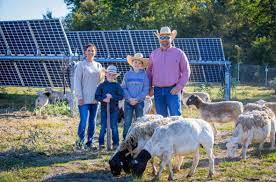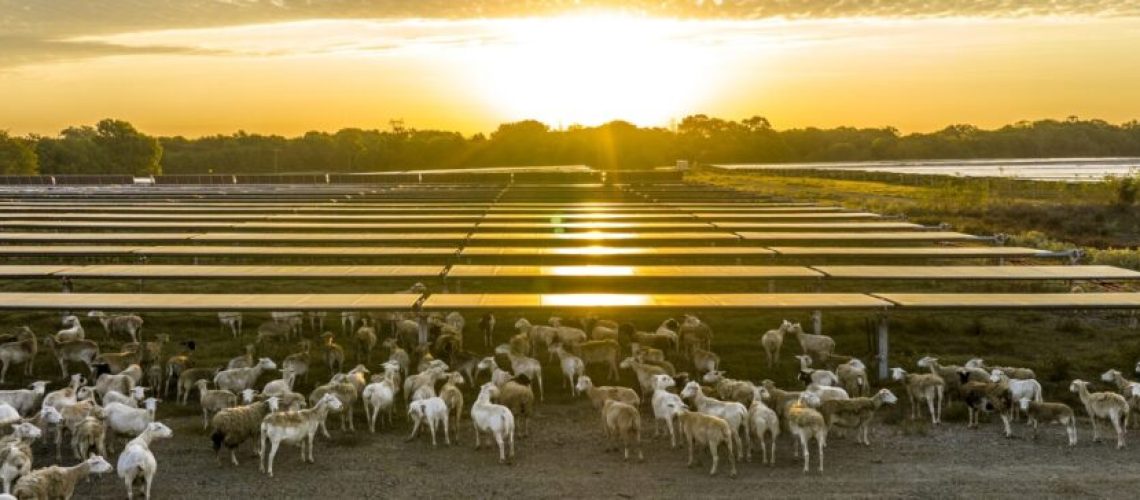Sheep grazers, bee pollinators, solar tracking hardware vendors and small to utility-scale project developers were among a diverse set of groups represented at the inaugural U.S. agrivoltaics conference this week that was located next to a gateway for U.S. travel, Chicago O’Hare International Airport. The Solar Farm Summit 2023’s choice of location, the American heartland, was a focal point of the confluence of attendees and recent policy initiatives promoting the use of projects of 10 MW or less with active agriculture processes. Some of these include sheep and cow grazing, vegetable and fruit production, and various other organic crop produce.
The first Solar Farm Summit, which took place March 14 to 15, drew an over-capacity filled Hilton hotel, as sheep grazers sat amongst seed vendors and community solar project developers alike. On the first day of the conference, the Summit recorded 460 attendees with printed badges, while speaking with pv magazine USA, executive producer Dan French said the number was likely above 500 strong.
Most attendees expressed a mixed zeal to disbelief that the emerging solar plus farming niche was really taking off, in the form of a conference and small trade show that is, while many attendees hailed from Corn Belt to Mid-Atlantic region universities sought to learn about the various facets of solutions from energy to seed harvesting.
Large-scale developer Silicon Ranch, based in Nashville, showed its first mover advantage in using methods of agrivoltaic solutions over the last few years on southeast to midwestern projects which range from 50 MW to 150 MW and above. The conference appeared to draw new entrants to agrivoltaics, such as EDF Renewables and Savion, which have hired agriculture professionals over recent years to branch into the nascent agrivoltaics market.
Utility-scale sheep
The utility solar market’s presence at the conference showed the initiative and willingness to promote sustainable farming methods and use agrivoltaics technologies like sheep grazing in large solar development. However, a caveat emerged of the dual-use nature of agrivoltaics, which combines on-site solar arrays and producing crops or livestock underneath panel arrays. As a method of creating farm and energy production from a levelized cost of energy (LCOE) perspective, agrivoltaics is best utilized from smaller distributed generation projects like community solar projects that range from about 2 MW to 10 MW, said development executives from Silicon Ranch, Lightstar Renewables and Empower Energy.
Independent power producers and project developers on projects from 100 MW to 200 MW in power capacity will spend $750,000 to $950,000 on average per year to mow grassy fields and hilly terrain where rows of solar panels can stretch as far as the eye can see, said Ethan Winter, National Smart Solar Director of the American Farmland Trust.
Using solar grazing with the deployment of up to 100 sheep on a solar project site, the use of agrivoltaic solutions would reduce the utility-scale developer’s mowing needs to two mowings per years, and reduce the cost of traditional mowing services to about $200,000 from the use of ewes alone, said Winter and Loran Shallenberger, director of regenerative operations at Silicon Ranch.
Shallenberger told pv magazine USA that scheduled traditional mowing is still required for utility solar projects, especially as the size of such projects continues to grow above 200 MW per project. But capital costs that can range up to $1 million on average mowing costs for a large project can be significantly reduced by the use of solar grazing methods, typically involving sheep or other friendly livestock, both Winter and Shallenberger said.
Solar grazing in its southeast region typically involves two ewes per acre, so a sample 100 MW solar project that sits on approximately 1,000 acres would require about 2,000 ewes to provide year-round grazing services, Shallenberger said. Silicon Ranch uses traditional mowing as well as ewes on the majority of its U.S. solar portfolio, he added.
Various grazers and sheep herding organizations spoke throughout the two-day conference’s sessions, with various farmers showing capacity of up to a few thousand sheep available for dispatch on a variety of regional 10 MW sized projects in the Midwest, Virginia and Pennsylvania.

J.R. Howard, owner of sheep and livestock rancher Texas Solar Sheep and donning an over-sized bucket hat, conveyed the age-old adage of “everything is bigger in Texas,” remains true even for the nascent agrivoltaics market. A previous West Texas oilfield energy foreman, Howard now says his ranching company manages a sheep count of up to 10,000 ewes, able to be deployed across a variety of solar sites across Texas.
In partnership with lightsource BP, Howard’s business grazes up to 2,000 ewes at a 260 MW(DC) utility solar project in Lamar County, Texas. Sheep are grazed in groups of 50 on average, while in rare cases 250 to 500 head may be deployed at one time, Howard said during a Solar Rancher’s Forum panel discussion on March 15.
At the lightsource BP project, the sheep fleet grazes on 18 pastures across the 260 MW project year-round, with the solar panels providing shade and relief for the sheep grazing crew. The global renewable energy business partly owned by BP reduces its service costs and lowers carbon emissions from solar grazing.
At the moment, solar grazing provides the greatest incentives for community projects of under 10 MW, or just under 100 acres, said Lucy Bullock-Sieger, vice president of strategy, Lightstar Renewables.
Under grazing agreements, service providers deploying sheep herds on solar sites must adhere to a 24-inch maximum vegetation height on land that is groomed by dozens of ewes, said Silicon Ranch’s Shallenberger.
While Shallenberger and Howard agreed the use of sheep as an agrivoltaic tool for servicing large project down to rural community projects could cause a shortage of sheep over the next year, they pointed to the resilient nature of the sheep’s ecosystem, not prone to parasitic infections or medical conditions, and require minimal supervision and fencing systems while grazing quadrants of large projects.
The Solar Rancher’s Forum panel agreed that grazers will have a resident veterinarian on-site with sheep grazers, sheep herds have shown to be strong and resilient to parasitic infections, while any incidents that arise can be isolated without spreading infection.
Canines such as Border Collies are the go-to pick for solar grazing field shepherds, said Howard and Marcus Gray of Gray’s LambScaping, a regional sheep herder in Virginia. With minimal supervision required, Border Collies are typically able to direct sheep back to a paddock or central location, though occasionally Gray will attach a GPS tracking device to his dogs’ collar, if one of his shepherds is guiding a ewe in a far corner of a thousand-acre solar field and can’t be heard.
Solar grazers said that from community projects located at Susquehanna University to utility-scale solar projects in Texas, annual insurance premiums to cover sheep herds ranges from $4,000 to $10,000 on average, said Caroline Owens from Owens Farms, a Pennsylvania herder managing a 40-head ewe count, and Lexi Hain, director of agrivoltaics and land management for lightsource BP, a former farmer from Ithaca, N.Y. Byron Komenick, owner of the first U.S. agrivoltaic project, Jack’s Solar Garden, in Longmount, Colo., said in Boulder County his firm pays upwards of $25,000 per year to insure his grazing operation.
The burgeoning community solar market in New York state could command an increase in sheep husbrandy and livestock promotion as a solar operations and maintenance solution, as the Empire State currently has about 80,000 sheep, Hain said.



